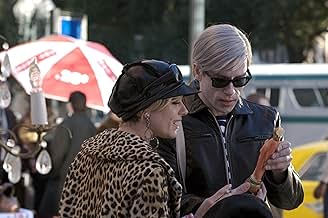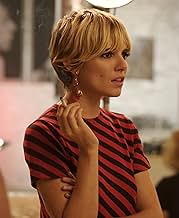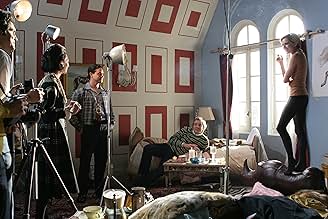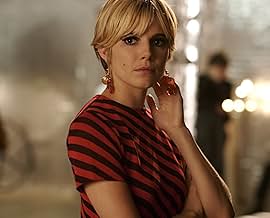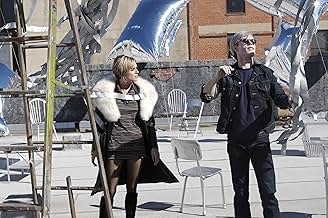Ajouter une intrigue dans votre langueBased on the rise and fall of socialite Edie Sedgwick, concentrating on her relationships with Andy Warhol and a folk singer.Based on the rise and fall of socialite Edie Sedgwick, concentrating on her relationships with Andy Warhol and a folk singer.Based on the rise and fall of socialite Edie Sedgwick, concentrating on her relationships with Andy Warhol and a folk singer.
- Réalisation
- Scénario
- Casting principal
- Récompenses
- 1 nomination au total
Avis à la une
Guy Pearce delivers a very acceptable performance. Hayden Christensen, playing a fictional character so obviously meant to be Bob Dylan, is ludicrously weak, having none of the self-containment and gravitas of a great musician and poet, even a young one. Sienna Miller is a revelation, and worthier of a much better film than this one, which is flawed by poor conceptualisation. Even before it was completed, Factory Girl alienates the people who could have helped to make it great.
Some of the Factory denizens who bought into and eventually shared Warhol's artistic vision became products of his genius in a conscious way. They achieved independence and recognition in their own right. People like Paul Morrissey, the Velvet Underground (including Lou Reed, John Cale, and Nico). Edie Sedgwick, sadly, lost sight of the artist within her and never quite made it. She wanted to be famous - Warhol gave her that. She would have needed her own creative diligence to consciously realise what made her a star and so become autonomously successful.
To be fair to the film, the complaints, lawsuits and criticisms of the likes of Lou Reed and Bob Dylan seem without substance. The film does not blame Warhol or Dylan for Sedgwick's demise. The panda-eyed, drug-abusing wash-out that is the Sedgwick nearer the end of the movie does, but the audience can hardly say anything except she brought about her own downfall: she ingratiated herself to Warhol and his world when she was a nobody without even a job, then moaned that she couldn't work when he dumped her, when in fact she was obviously unemployable because of her drug habit.
The film's only real crime is perhaps that it celebrates the life of Edie rather than Andy, and that not particularly well. Seeing her at her height through the eyes of Andy Warhol would have achieved much more. Both 'sides' of the bitter split between the two of them agree she had, at one point, remarkable presence, charisma, and on screen talent. An occasionally more Warholian approach to the cinematography, while keeping the film accessible, could have emphasised such qualities with self-conscious camera-work and other devices. Instead, we have determinedly Hollywood-style continuity-editing. Warhol devices such as split-screen are used for window dressing rather than any discernible emotional impact. Similarly, variations in film stock pay lip service to a Warhol vibe rather than building an awareness of Edie's inner persona.
Warhol was not only the most famous exponent of Pop art, but one of the most important exponents of New American Cinema. His techniques influenced both Hollywood and experimental film, and his style affected censorship laws and developed the 'camp aesthetic' (defined by Susan Sontag as, "the love of the exaggerated, the 'off', of things being what they are not"). Factory Girl capitalises on the name, but is mainstream through and through.
If the producers had worked with people of real vision; if they had secured song rights for music by Velvet Underground and Bob Dylan (which would have helped establish historical and cultural context); if they had portrayed the beauty and sparkle of Edie Sedgwick through the eyes and genius of Warhol or someone like him; if they had made insightful recognition of her weakness and her greatness, then this could have been a work of art. For Warhol and Dylan enthusiasts it is full of Campbell's Soup Cans and shots reminiscent of album covers - but without depth. Some will see a slightly offensive depiction of Warhol as a bloodsucker (he didn't pay the experimental artists who gathered in his studio or appeared in his films). For more casual viewers it is a slightly poignant story of the rise and fall of a quintessential American IT girl in a Pop Art universe bursting with sex, drugs, art and rock 'n' roll. Factory Girl is Hollywood factory rather than Warhol Factory. But should it be decried because of that?
First off there's the acting which is all over the place, some people are doing great while others aren't allowed enough room. Casting Sienna Miller was a good call, its a difficult role to cast but if they felt they had to go with a "name" then Sienna was the right choice. As for Guy Pearce as Andy Warhol, that really worked and its a true shame that the film was such a mess you couldn't realize that Guy Pearce was turning in an excellent performance. Especially if you have seen his work in L.A. Confidential and Memento, I had to remind myself a few times oh yea thats Guy Pearce. Had Factory Girl functioned as a GOOD FILM Guy Pearce would have received much more acclaim.
As for Hayden Christensen, I like him alright as an actor but his role as the Bob Dylan-esquire Musician just wasn't allowed much room. He was crammed into a corner spouting out cliché lines and trying his best to do an impression rather than an interpretation. This film was around 90 minutes long, and it should have been around 2 hours long considering all of the significant characters. You can't just brush by Andy Warhol and Bob Dylan (even though they don't officially call the Bob Dylan character Bob Dylan).
What I did like about this movie was that Warhol was portrayed as a little bit cold and detached, but Sedgwick was portrayed as being equally messed up and responsible for her own downfall. So the blame wasn't placed anywhere. Having actors like Jimmy Fallon and one of the Olsen twins in this movie only made me go "what are they doing here?" Pearce and Miller really did give it there all, and even that wasn't enough to elevate this sometimes incoherent mess. Its a mess, but I was still interested thanks to the two leads. I can't wait until Sienna Miller is given a lead role in a GOOD movie.
Okay, let me say that I enjoyed Factory Girl for what it is and think it is worth renting.
The story stars Sienna Miller as the fated Edie Sedgwick and Guy Pearace as vapid pop culture icon, Andy Warhol.
The movie isn't nearly as close to as bad as critics claim it is. The first 40 minutes is much ado about talk of cocks, Andy and Edie's irreverence, and a series of disjointed images. The first act is aimless. But it makes sense because Edie and Andy are aimless and so are the termites chewing Andy's wood at "The Factory".
Enter Hayden Christensen as Billy Quinn and the movie develops its paper thin plot. Though, I should say it's unfair to characterize the story this way. Edie's life was a paper thin plot, so the director, Hickenlooper can't be blamed for that.
Andy, who never says he is gay, though everyone else assumes (or knows) he is, is in love with the idea of Edie "The Superstar" and Billy Quinn simply wants to open her eyes. She becomes the rope in a tug of war. Billy's "soul" cries for the world in a time of upheaval versus the-devil-may-care, drug den world of Andy. And while the latter may be in "love" with his muse, Billy cares and wants Edie to know, if art is the food of the soul, then Edie is eating from an empty soup can.
Edie is a sympathetic character. You get the sense that no one really knew her. Not because she was empty and vapid but that she was so shattered inside the only part of herself she allowed the world to see was the facade her Andy created. In Factory Girl we see Edie through the looking glass. Not as she was, but as she appeared. Warped.
Edie is the cute girl you meet in passing at a party at some stranger's house. You like her, but never see her again. Though, over the years you hear the occasional rumor or two, until one day, you hear she's hit rock bottom and died. That's how it feels to watch Edie Sedgewick's story in The Factory Girl. On one hand, you want to mourn her. On the other hand, you wonder, what has the world lost? That in itself is the real tragedy.
Le saviez-vous
- AnecdotesSienna Miller improvised the scene in which Edie tells The Musician about her brothers' deaths.
- GaffesEdie Sedgwick's relationship to Nico is depicted incorrectly: in reality they were friends and Edie warned Nico about Andy Warhol's behavior. Edie's death was very sad for Nico.
- Citations
Andy Warhol: I wonder if people are going to remember us?
Edie Sedgwick: What, when we're dead?
Andy Warhol: Yeah.
Edie Sedgwick: Well, I think people will talk about how you changed the world.
Andy Warhol: I wonder what they'll say about you... in your obituary. I like that word.
Edie Sedgwick: Nothing nice, I don't think.
Andy Warhol: No no, come on. They'd say, "Edith Minturn Sedgwick: beautiful artist and actress...
Edie Sedgwick: ...and all-around loon.
Andy Warhol: ...Remembered for setting the world on fire...
Edie Sedgwick: ...and escaping the clutches of her terrifying family...
Andy Warhol: ...Made friends with eeeeverybody and anybody...
Edie Sedgwick: ...creating chaos and uproar wherever she went. Divorced as many times as she married, she leaves only good wishes behind.
[laughs]
Edie Sedgwick: That's nice, isn't it?
- Crédits fousDuring the first part of the end credits, photos are shown of the real Edie Sedgwick. Also people who knew her give testimonies about her.
- Versions alternativesAccording to the FAQ section: "For the home theatre market, an unrated version was released aside from the R-rated theatrical version. Most scenes which were re-inserted or alternately shifted, serve to specify character drawings and various aspects of the story which were only embedded in the theatrical version to some extent. However, there are also a few extensions with sexual contents and more explicit depictions of drug use."
- Bandes originalesDino's Song
Written by Chet Powers (uncredited)
Performed by Quicksilver Messenger Service
Courtesy of Capitol Records
Under License from EMI Film & Television Music
Meilleurs choix
- How long is Factory Girl?Alimenté par Alexa
- What did Edie's brother say that he tasted until the day he died?
- Why is Hayden Christensen's character listed as "Musician" and no longer as Billy Quinn?
- What are the differences between the Theatrical Version and the Unrated Version?
Détails
- Date de sortie
- Pays d’origine
- Langues
- Aussi connu sous le nom de
- Fábrica de sueños
- Lieux de tournage
- Sociétés de production
- Voir plus de crédits d'entreprise sur IMDbPro
Box-office
- Budget
- 7 000 000 $US (estimé)
- Montant brut aux États-Unis et au Canada
- 1 675 241 $US
- Montant brut mondial
- 3 572 632 $US
- Durée1 heure 40 minutes
- Couleur
- Mixage
- Rapport de forme
- 1.85 : 1
Contribuer à cette page




